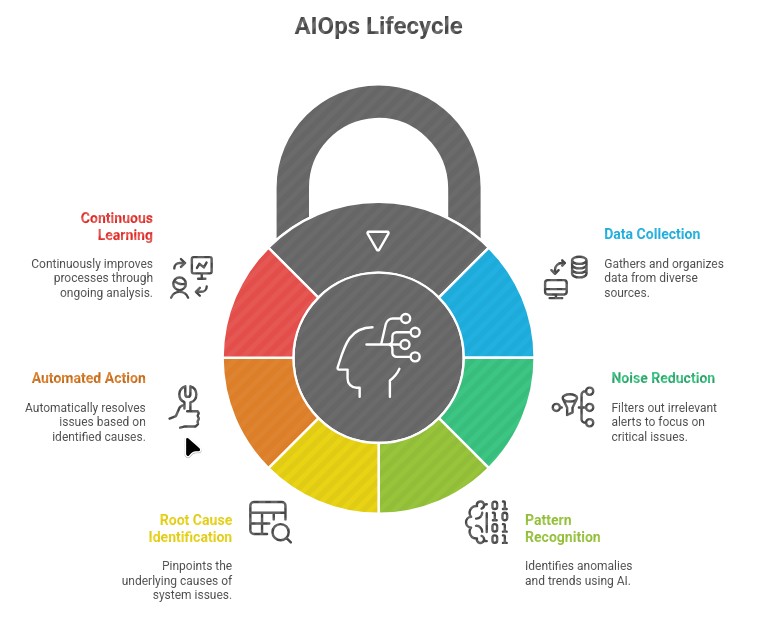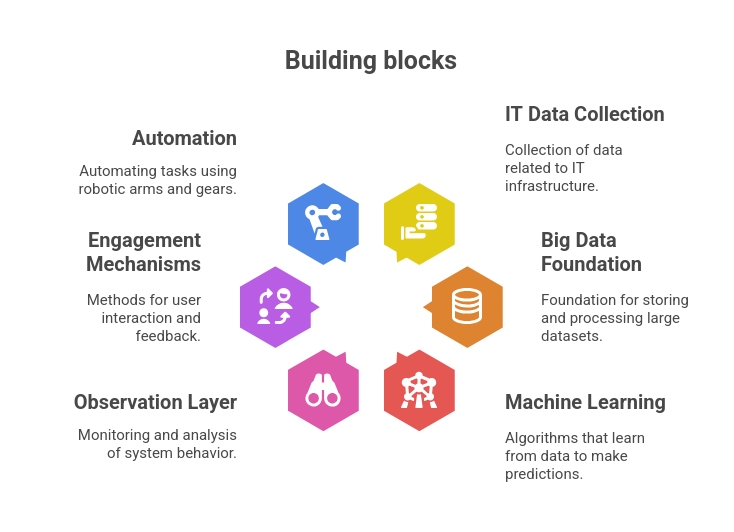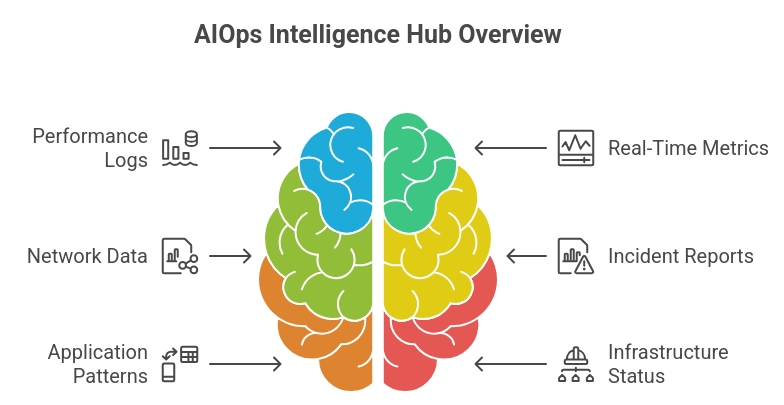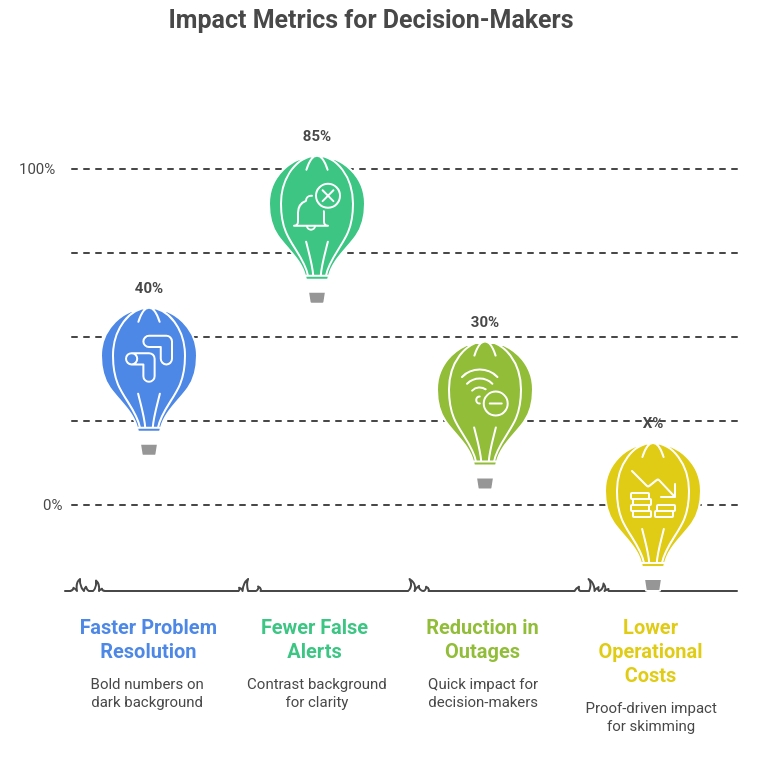Understand AIOps, its working, components, and benefits in IT operations for faster problem-solving, better observability, and reduced downtime. Our AIOps support experts are on call whenever you need them.
What is AIOps? A Beginner’s Guide
Ask any IT leader what keeps them awake at night, and you’ll likely hear the same answers: constant alerts, unclear root causes, and systems that seem to break without warning. In today’s interconnected business environment, managing IT infrastructure has turned into a juggling act, one wrong move, and downtime can ripple across the organization.
The reality is that the human eye and traditional tools alone can’t keep pace with the scale and speed of today’s operations. And that’s where an AIOps platform for IT operations comes into play, not as another dashboard to stare at, but as a smart, adaptive system that learns, predicts, and takes action before problems snowball.
This guide breaks down exactly what it is, how it works, its core elements, and why so many businesses are moving in this direction. You’ll get a clear picture without the fluff, because IT teams don’t need hype; they need solutions.
An Overview
Breaking Down the Concept
AIOps stands for Artificial Intelligence for IT Operations. At its core, it’s the application of advanced analytics, natural language processing, and machine learning to manage, automate, and optimize IT workflows. Think of it as a high-performance command center that doesn’t just monitor systems, it understands them, learns from them, and acts when necessary.
It works by collecting massive volumes of data from various systems, filtering out the noise, and identifying the patterns that actually matter. Once the relevant signals are spotted, the platform either alerts the right team or takes predefined action to prevent a potential issue.
How AIOps Functions in the Real World
Instead of relying on scattered monitoring tools and manual intervention, AIOps unifies everything into one platform. This is how it works step by step:
Data Collection and Aggregation
- Pulls data from performance monitoring tools, ticketing systems, logs, metrics, and more.
- Integrates both historical and real-time information into one source.
Noise Reduction
- Filters out low-value alerts.
- Focuses only on anomalies that matter to system performance and stability.

Pattern Recognition
- Uses algorithms to find recurring issues or unusual behaviors.
- Identifies dependencies and relationships across systems.
Root Cause Identification
- Correlates multiple alerts to pinpoint the actual cause.
- Avoids trial-and-error troubleshooting, saving critical time.
Action and Resolution
- Automates predefined fixes or triggers human intervention.
- Can prevent outages before they happen.
Continuous Learning
- Adapts to changes in the environment.
- Improves accuracy of predictions over time.
Core Components You Need to Know
Any strong AIOps setup revolves around several core elements. Each plays a distinct role in keeping systems running at peak performance.
- Extensive IT Data Collection
By breaking down archives, AIOps platforms gather information from across the IT environment, service management tools, monitoring software, and cloud or on-premise infrastructure. This broad view makes it easier to identify the true cause of a problem.
- Big Data Foundation
Large volumes of historical and live data form the heart of the system. Without this foundation, advanced analytics and automation wouldn’t be possible.
- Machine Learning Capabilities
From anomaly detection to predictive analysis, machine learning makes it possible to handle complex datasets at speeds humans simply can’t match.
- Observation Layer
Collects insights from multiple environments, cloud, containers, legacy systems, in real time. This ensures that problem detection is based on the most current state of the system.
- Engagement Mechanisms
Facilitates the coordination of resources and tasks across different IT domains, improving collaboration and accuracy.
- Action-Oriented Automation
Executes automated workflows to resolve or prevent problems, freeing up IT teams to focus on strategic work.

Key Capabilities That Drive Results
- Anomaly Detection
Constantly monitors for unexpected patterns, even if it’s an unusual spike in CPU usage or an odd login attempt, and flags them instantly.
- Event Correlation and Analysis
Connects separate incidents into a unified picture. For example, slow application load times, an overloaded server, and a failed API call might all stem from one underlying cause.
- Root Cause Analysis
Shortens the time it takes to identify what’s actually wrong, removing the guesswork from incident management.
- Predictive Insights
Anticipates resource shortages or performance dips before they affect users, giving IT teams the chance to act early.
- Intelligent Automation
Takes immediate action when certain thresholds or conditions are met, like scaling resources when memory usage climbs beyond safe limits.
Where the Data Comes From
To function effectively, AIOps taps into a broad mix of data sources:
- Historical system performance logs
- Real-time metrics and alerts
- Network packet data
- Incident management systems
- Application usage patterns
- Infrastructure status reports
By analyzing these datasets together, it distinguishes between minor fluctuations and events that signal genuine trouble.

Building Blocks of an Effective Implementation
Instead of listing “steps,” let’s walk through the essential stages organizations follow to make AIOps a reality:
- Define the Goals
Understand which operational pain points you want to address, such as reducing downtime or improving incident response speed.
- Select the Right Tools
Look for platforms with strong observability, predictive analytics, and automation capabilities.
- Integrate Data Sources
Connect your existing monitoring systems, ticketing tools, and logs into the new platform.
- Configure Automation Rules
Set clear conditions for when the system should act automatically versus when it should alert a human.
- Train the System
Feed it historical data so it can recognize common patterns and make better predictions.
- Monitor and Refine
Review results regularly and fine-tune the rules and models to match evolving needs.
Why Businesses Are Adopting It Now
The push towards AIOps adoption is driven by several realities:
- IT environments are sprawling across multiple clouds and data centers.
- Data volumes are too large for manual monitoring.
- Users expect instant performance, 24/7.
- Budgets are tight, forcing teams to do more with less.
- Cyber threats are evolving too quickly for human-only defense.
Tangible Benefits
- Faster Problem Resolution
Cuts through irrelevant alerts, correlates critical data, and accelerates root cause identification, slashing mean time to repair.
- Reduced Costs
Automates repetitive tasks, allowing teams to focus on higher-value work, while reducing the risk of costly downtime.
- Improved Collaboration
Integrates monitoring tools so DevOps, IT, and security teams can work from the same data.
- Predictive Management
Prioritizes urgent alerts and flags upcoming issues before they disrupt operations.

[Need assistance with a different issue? Our team is available 24/7.]
Positioning for the Future
In modern IT operations, standing still isn’t an option. AIOps doesn’t just react, it prepares. By continuously learning from data, adapting to infrastructure changes, and automating where possible, it offers a way to manage complexity without sacrificing performance or uptime.
For organizations aiming to stay ahead, the question isn’t if they should adopt AIOps; it’s how soon.







0 Comments